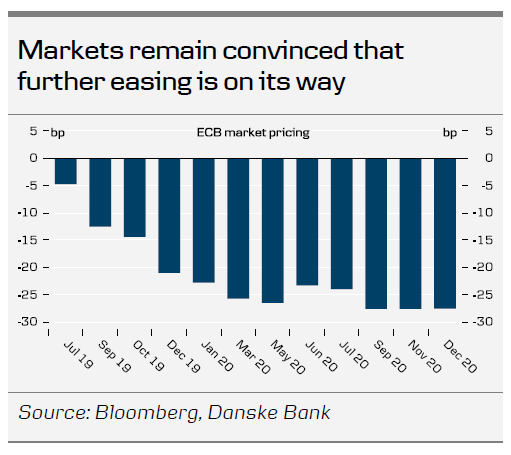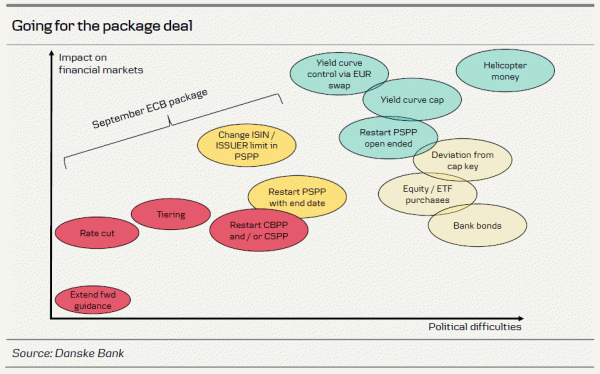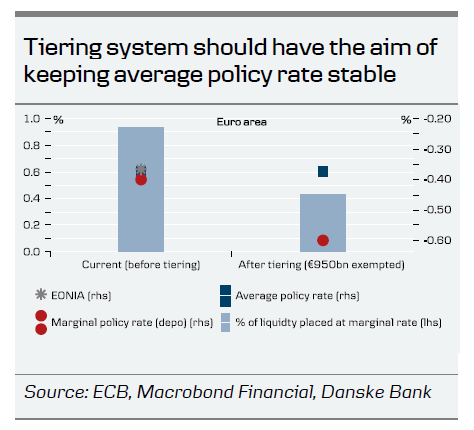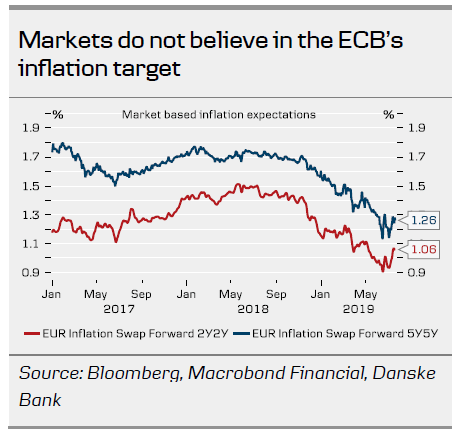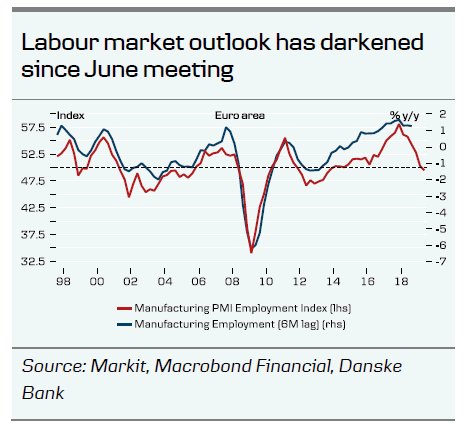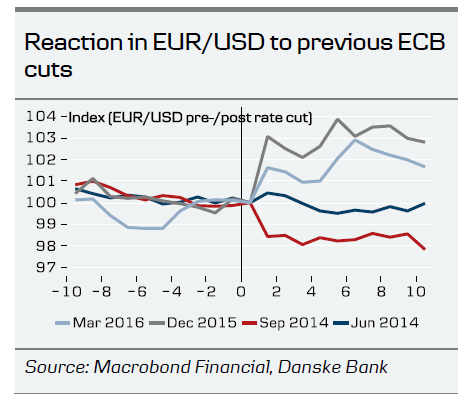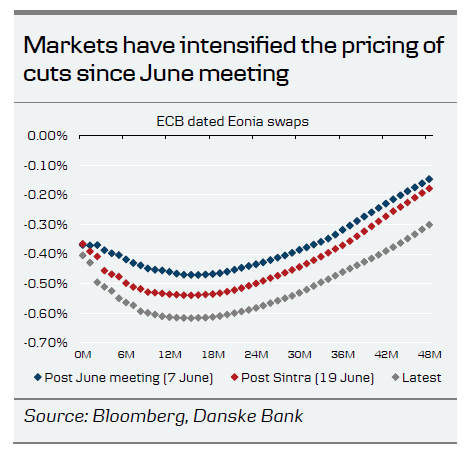- It is a matter of when and how rather than if ECB will ease monetary policy. After Draghi’s dovish Sintra speech, lack of improvement in growth and inflation, and comments from ECB GC members, the case for further easing has strengthened.
- We expect the ECB to tweak forward guidance at the July meeting, setting the scene for a comprehensive easing package to be unveiled in September (depo rate cut, tiering, QE restart and forward guidance). We could already see the ECB tasking committees to examine the easing package including tiering (again).
- FI Markets may be disappointed at the July meeting for lacking details on new stimuli. However, we would expect any FI sell-off to be short-lived as focus turns to the expected easing at the September meeting. For FX, we expect the September meeting to be more pivotal than the July meeting
As leadership change at the helm of the ECB gets underway, both Mario Draghi’s Sintra speech and the June minutes all but confirmed that Draghi’s term will culminate in another big easing package. Economic data has remained lacklustre (see more below), and hence in a first step we expect the Governing Council (GC) to adjust the forward guidance at the 25 July meeting to include a reference to further easing similar to the wording “at present or lower levels” that was used up until June 2017. This should set the scene for a deposit rate cut, which we expect to be announced at the September meeting (we expect a 20bp rate cut), paired with a restart of the QE programme and extended forward guidance (see ECB Research – New ECB call – rate cut and restart of QE).
While a preference for further stimulus has been well signalled by various ECB members in recent weeks, for example Coeuré and Rehn, much debate continues to centre on the timing and design of the exact policy measures. We cannot rule out measures coming already at the July meeting, but overall find it premature (an ECB sources story, that suggested that GC members were in no rush for a July decision, supports our view).
The lack of urgency was a message also borne out in the June minutes that showed discussion on concrete policy steps remained at a very preliminary stage (albeit were prior to Draghi’s Sintra speech). Hence, our preference remains for an easing package only coming at the September meeting, alongside new staff projections. The uncertainty on design is high, but we see a QE restart as vital for the ECB’s easing package. We view an easing package without a QE restart as falling short of providing sufficient reassurance and stimuli to the market. For our elaborate deliberations about the preference for a package deal including room for an ECB QE restart, see ECB Research: New ECB call – rate cut and restart of QE, 18 June 2019, and Government Bonds Weekly, 21 June 2019.
Regarding further alterations to the forward guidance, the June meeting also launched an interesting discussion amid the GC about the need to adopt a more “symmetrical” interpretation of the inflation target, i.e. where the ECB would tolerate inflation above the target to compensate for persistent undershooting in recent years. Although we think such a switch to a more state-dependent and less calendar-based forward guidance could help alleviate the risk of de-anchoring inflation expectations, we do not see such changes as imminent – and would also be highly dependent on whether markets believe the ECB could achieve an overshooting. However, last Thursday, Bloomberg reported that the GC already received a presentation on the effectiveness of the current target. Nevertheless, it could be the advent of a discussion that would get further traction under a Lagarde-led ECB (see ECB Research – Lagarde to take ‘one of the most difficult’ jobs).
Committees to look into tiering system
As the ECB mulls another rate cut, the introduction of a tiered deposit rate system continues to be an integral part of the discussion. At the June meeting, the ECB concluded that the benefits of the negative interest rate policy continue to outweigh the drawbacks, but it left the door open for ‘mitigating measures’ should policy rates be decreased further in the future. Hence, as part of the policy package announced in September, we expect the ECB to introduce a tiering system. The aim would be to keep short-term money market rates (i.e. EONIA/€STR) close to the marginal rate (deposit rate) to ensure the transmission of easier financial conditions to the real economy. At the same time, to support banks’ profitability, the system should be designed to ensure the average deposit rate banks pay to the ECB remains close to the current level of just shy of -40bp in order to minimise negative repercussions on lending rates.
A tiering system could be designed in a number of ways depending what the ECB wants to achieve. We doubt that work in the ECB on this complex topic has been finalised yet. A number of hurdles need to be taken into account, including how to tailor a tiering system to the heterogeneous European banking system, the impact on repo markets and the €STR/EONIA transition set for 1 October. Currently, we lean towards a solution that would mirror the Swiss approach, where a multiple of required reserves is exempt from the deposit rate, but the uncertainty is high, naturally. We note that to keep the average deposit rate faced by banks broadly unchanged after a 20bp cut, a quick back of the envelope calculation indicates around EUR950bn of excess reserves (more than 7x the current reserve requirement) would need to be exempted and allowed to be remunerated at the higher rate. Finally, we highlight that a tiered deposit rate system even risks adding upward pressure on money market rates if not designed and adopted by markets optimally. Hence, in light of the complexity of the issue, we think the ECB would tread carefully in rolling out a tiering system to avoid creating additional volatility in financial markets. This means a clear communication on tiering might only come sometime after the actual rate cut, i.e. at the October or December meetings, but that should not keep the GC from already tasking committees to look into the issue at the July meeting.
Economic outlook has not improved
The ECB’s hope for an improvement in economic data since the June meeting has proven elusive. The industrial sector is on track to return as a drag on growth in Q2 and PMIs and Ifo continue to tell a story of subdued growth. Furthermore, vulnerabilities have started to show in the so-far-robust labour market with business surveys now signalling that manufacturing employment growth will start to go into reverse in H2 19 (see also Euro Area Research – Catching up with reality). Core inflation continues to fluctuate around the 1% level and remains highly influenced by seasonal effects. Market-based inflation expectations have recovered to 1.26% – close to their post-Sintra peak – but they probably remain too low for the ECB to stay complacent about the fall in breakevens. That said, in a recent speech, board member Benoît Coeuré downplayed the relevance of market-based inflation expectations as a gauge of de-anchored inflation expectations, stressing that policymakers should focus instead on a broad set of inflation expectations indicators. Specifically, the ECB uses its survey of professional forecasters, which will be published the day after the ECB meeting. The GC will be aware of the outcome and will likely closely watch that result.
In his Sintra speech, Draghi highlighted that “In the absence of improvement, such that the sustained return of inflation to our aim is threatened, additional stimulus will be required.” Based on the latest macro data signals, the case for further easing measures is there. Whether it would do much to alleviate the current growth weakness and kick-start the economy is an altogether different question. Here, we remain sceptical, since borrowing costs are already very low and a lack of (external) demand rather than too-tight financial conditions remains the key issue. In that light, fiscal policy remains the most effective channel to brighten the euro area growth and inflation outlook in our view.
FX: Rate cuts are all that matter
For the EUR, the outcome of the upcoming ECB meetings has become highly important. Our long-held view remains that what matters for the EUR is what the ECB can do to create inflation and in that light it is the rate cutting part of the easing package that really matters for FX markets (see FX Edge: The EUR and ECB – rate cuts are all that matter). A sizeable cut in the deposit rate (and 20bp is a bare minimum in our view) would force a greater share of excess liquidity on the market, help turn around inflation expectations and weaken the EUR. However, history has shown that market expectations have tended to exceed the ECB’s eventual easing package announcement at the time of the ECB policy meetings. A tiering system might further erode the effect and push the EUR higher. Overall, we do not expect much market reaction in July, but rather consider the September meeting to be pivotal for the EUR.
Fixed income: Focus will soon be on September and FI rally to continue
Last week, the market lowered the probability of an ECB cut at the July meeting and moved away from expecting a 50bp cut from the Fed. This pushed 10Y Bund yields (DBR 0.25% 02/29) to -0.25% from the -0.40% seen in early July. However, this week, the EGB rally has returned, pushing 10Y yields back to -0.32%.
There is risk that the ECB meeting might be an initial disappointment for the FI markets given no rate cut at this stage. However, we expect any FI sell-off to be shortlived. Given the change in forward guidance, market focus will quickly turn to the September meeting, we believe. Here, we expect the market to buy into our ‘big easing package’ view.
All in all, we stick to the view that 10Y Bund yields will drop to -0.45% over the next 1-2 months. It also means that the hunt for carry or struggle to avoid negative yields is intensifying. Hence, we keep a positive view on periphery and semi-core. Our favourites remain Spain, Portugal and Finland in semi-core




